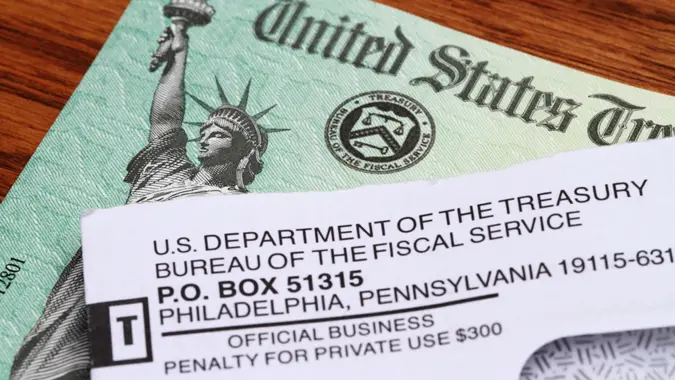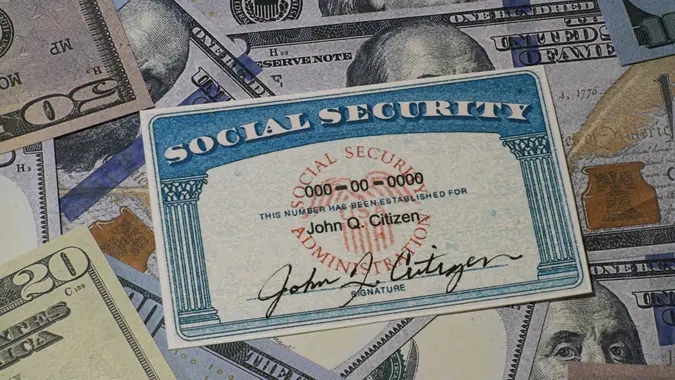Avoid These 4 Mistakes If You’re Claiming Social Security in 2026

Commitment to Our Readers
GOBankingRates' editorial team is committed to bringing you unbiased reviews and information. We use data-driven methodologies to evaluate financial products and services - our reviews and ratings are not influenced by advertisers. You can read more about our editorial guidelines and our products and services review methodology.

20 Years
Helping You Live Richer

Reviewed
by Experts

Trusted by
Millions of Readers
You’ve done it. You’ve reached the end of your shift and can punch out of work, permanently. Now, you’ll finally be reaping some of the rewards of a lifetime of working hard and paying your taxes. Finally, it’s time to sit back and collect your Social Security payments, right?
Although you might feel like you can simply file for Social Security and ride off into the sunset, the truth is that there’s much more to the process. By planning ahead, you can not only avoid making potentially serious mistakes with your Social Security check or Supplemental Security Income (SSI), but you can also ensure that you’re receiving the maximum benefit amount that you can.
Here are four missteps you’ll want to avoid if you’re claiming Social Security in 2025.
Not Understanding FRA
Full retirement age (FRA) is an important concept when it comes to Social Security. Although you can claim your benefits as early as age 62, full retirement age, as the name implies, is when you earn your full Social Security benefit. If you claim your benefits before FRA, they will be permanently reduced for the rest of your life.
Keep in mind that full retirement age is 67 for those born in 1960 or later, so if you’re 66 in 2025, full retirement age is 66 years and 10 months. For example, if you aren’t aware of the difference a few months can make and plan on claiming benefits at age 66 years and 8 months, you’ll technically be filing early. This means you’ll forever be locking in a lower monthly payout, thus reducing your benefits.
Expecting a Huge COLA
Every year, the Social Security Administration (SSA) evaluates benefits and typically raises them in line with inflation so that beneficiaries don’t experience a loss in purchasing power. This is called a cost-of-living adjustment, or COLA.
Just two years ago, in 2023, when inflation was at its highest levels in 40 years, the COLA was a whopping 8.7%. But since then, the COLA has stayed under 4%. For 2026, Social Security beneficiaries will see a 2.8% COLA, which is greater than what it was for 2025 (2.5%) but still nowhere near double digits.
Overlooking Spousal Benefits
When you file for Social Security benefits, you’re entitled to the highest benefit possible based on either your own personal work record or that of your spouse. However, the spousal benefit is limited to 50% of the amount the prime beneficiary is receiving.
In other words, if your spouse receives a Social Security check of $2,000 per month, your maximum spousal benefit is $1,000. If this is more than you would receive based on your own work record, then you can still claim this benefit, even if you have never worked a day in your life. It’s important to check which benefit gives you the biggest paycheck.
Relying Only on Social Security
If you’re planning to retire this year, you won’t really have a lot of time to build up your other savings to supplement your Social Security payout. However, you could make some life changes to prepare for the fact that Social Security alone won’t likely fund your dream retirement.
For example, if you are retiring at the end of the year, you could absolutely max out your retirement plans and at least get a small head start before you draw your first Social Security check. Yet, it’s still good to know what’s ahead next year. Here are a few key takeaways for filing in 2026:
- The maximum retirement contribution for those under 50 to a 401(k), 403(b), or governmental 457 plan is $24,500
- For those aged 50 and over, an additional $8,000 can be contributed as a catch-up contribution, bringing the total to $32,500
- Workers between the ages of 60 and 63 may be eligible for a “super catch-up” contribution of up to $11,250, allowing a total contribution of $35,750
Another way to boost your retirement earnings instead of relying solely on Social Security is to consider a part-time job or side gig after you formally retire. This doesn’t have to be something burdensome. In fact, many seniors enjoy working a few hours a week doing something they love, all the while earning additional money for retirement.
If neither of those options is feasible for you, it’s important to acknowledge that you’ll likely have to downsize or otherwise trim expenses in retirement if you’re planning to rely on Social Security.
Final Take To GO: Claiming Social Security in 2026
Social Security is always a hot-button issue, but in times of economic uncertainty, it becomes increasingly difficult to navigate. Keep in mind that while the current White House administration has put everything from SNAP benefits to Social Security checks through the financial wringer, you’ll still be able to collect your monthly payment in 2026.
Caitlyn Moorhead contributed to the reporting for this article.
More From GOBankingRates
 Written by
Written by  Edited by
Edited by 

























